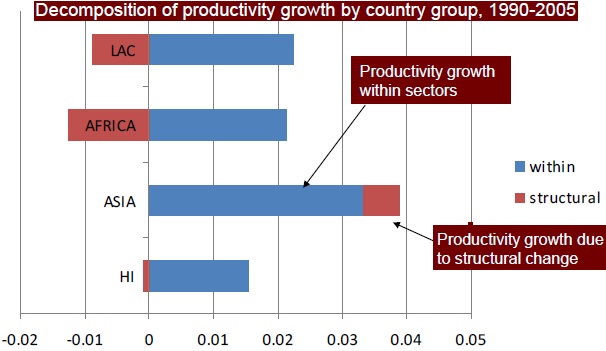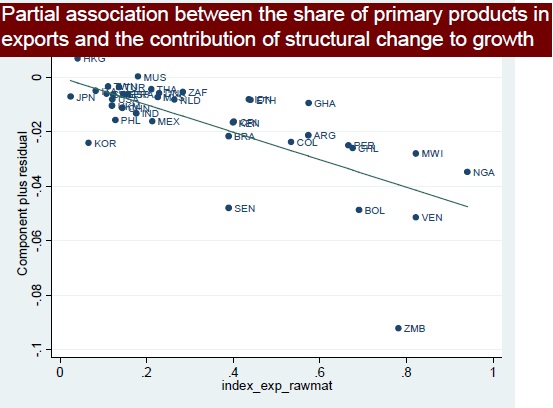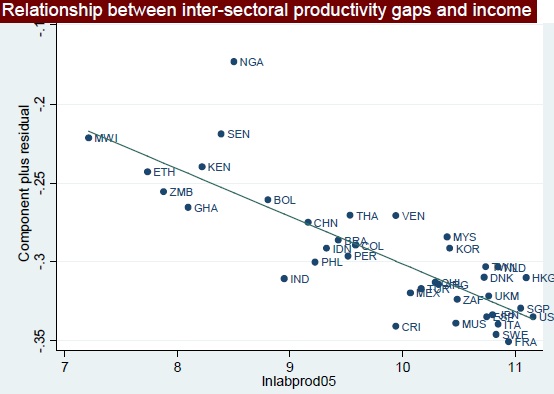This blog post is adapted from Robert C. Feenstra’s summary of research of the International Trade and Investment (ITI) Program at NBER. It summarizes various papers that explore and explain the causes of the great trade collapse of 2009. Here is a blog post about what economists thought were the reasons for the collapse in trade by about 30 of world GDP in 2009. Here is an earlier blog post adapted from Feenstra’s summary of recent literature on the great trade collapse of 2009.
In the ITI program an ongoing area of research is the impact of, and explanations for, trade policies. Some studies examine the impact of policies in particular sectors. One important example is the textile and apparel sector, which experienced a large reduction in quotas as the Multifibre Agreement was phased out in January 1, 2005. Many people expected that China would take over in this sector, since it had been the most constrained in its textile and apparel exports. But Harrigan and Geoffrey Barrows show that along with these changes in market shares, there was a massive downgrading in the type of product exported from China.1 These products at the lower end took sales away from countries such as Mexico or Guatemala, and to some extent served to offset the competitive impact on other Asian countries.
Another sector that has received attention for its ongoing trade policies is steel. Bruce Blonigen and co-authors show that the response of this industry to tariffs versus quotas, which they estimate, is highly sensitive to its market structure.2
Another topic of strong interest is the impact of free trade agreements, particularly on workers. This topic has received renewed interest for the United States in what might be considered "round two" of the debate over the impact of trade on wages and employment. Making use of broad changes in tariffs through trade agreement and detailed datasets on individuals, these studies identify potentially large effects of tariff reductions. A recent example is the work by David Autor, David Dorn, and Hanson, which examines the acceleration in Chinese exports to the United States following its WTO accession in 2001.3 They match the changes in wages and employment in local labor markets defined by "commuting zones" to the Chinese exporters to manufacturing industries in those zones. They link the rise in Chinese exports, and the implied reduction in employment, to changes in federal support payments to individuals for trade adjustment assistant, disability, retirement, and the like. They find that the deadweight loss from the increase in support payments is very similar in magnitude to the welfare gains from the increased imports: both are on the order of $30 - $70 annually per capita. But because the support payments are expected to be temporary while the welfare gains from imports are permanent, there are still gains from trade.
A second example of a study that uses data on individuals (from the decennial census) is the paper by John McLaren and Shushanik Hakobyan which analyzes the impact of NAFTA on local labor markets in the United States.4 Drawing on earlier theoretical work by McLaren, they allow for possible wage increases in response to anticipated tariffs cuts (as workers leave industries) and for wage decreases when the tariff cut occurs. They find a significant negative impact of NAFTA on blue-collar workers, with smaller positive or negative effects on college educated workers. Their overall message is that NAFTA has large distributional effects, even if its overall welfare impact is small.
All of these studies find sizable changes in trade flows following the enactment of the tariff changes, despite the fact that U.S. tariffs on Mexico were already low, and that tariffs on China were already at their MFN level before its accession to the WTO. Why can trade change so much in response to small tariff changes? Kyle Handley and Nuno Limao suggest that preferential agreements may reduce the policy uncertainly surrounding tariffs that could change in the future.5 They study Portugal, which was already a member of the EFTA and had an agreement with Spain when it joined the EEC in 1986. There was no drop in Portugal's tariffs with members of the EEC who were also in EFTA, but nevertheless there was a sizable increase in exports to EC members. Handley and Limao attribute this to a reduction in policy uncertainty, which they measure by the difference in the zero tariffs within the EEC and the MFN tariffs charged to outside members. Variation in that difference allows the researchers to identify the policy impact across industries and to explain the increase in trade.
In addition to these empirical studies, several members of the program, using game-theoretic techniques, have theoretically analyzed the question of why countries pursue preferential agreements. For example, Philippe Aghion, Antras, and Helpman model this as a question of sequential bargaining, whereby a country makes deals with a series of other countries, but the bargains negotiated must be consistent with the deals that potentially will be made in the future.6 The researchers show that this model generates both "building bloc" and "stumbling bloc" effects of preferential trade agreements, to use the terminology of Jagdish Bhagwati. In particular, they find conditions under which global free trade is attained when preferential trade agreements are permitted to form (a building bloc effect), and other conditions where global free trade is attained only when preferential trade agreements are forbidden (a stumbling bloc effect).
In a series of papers, Kyle Bagwell and Robert Staiger analyze games in which countries are constrained by the WTO rules and show that these rules can lead to welfare improvements.7 One example is the most-favored nation rule, which states that all WTO members must be treated equally. This rule means that a reduced trade barrier given to a current negotiating partner must be automatically extended to later partners. Bagwell and Staiger argue that the MFN principle makes it less likely for countries to be willing to offer concessions at early stages of the sequential bargaining process, but that this potential source of conflict can be offset by two other WTO principles: first, by renegotiation at later stages; second, by reciprocity in the concessions made by each country. Incorporating these principles into the bargaining game allows for an efficient outcome even under the MFN rule. This line of research enables Bagwell and Staiger to rationalize various provisions of the WTO.
There are other approaches, too, that can be used to rationalize the provisions to the WTO. Ralph Ossa uses a monopolistic competition model with a "home market" effect, whereby tariffs attract firms to enter the protected market.8 That framework can generate political economy considerations for trade policies and WTO rules that are similar to what arises from the terms-of-trade model. Using a different approach, Giovanni Maggi and his co-authors argue that WTO-type rules can be understood as arising from the inevitable incompleteness of trade agreements.9
The analysis of trade policy naturally leads to the question of the gains from international trade, and we conclude with this classic question. Analysis of the monopolistic competition model has shown that it gives rise to a remarkably simple formula for the gains from opening trade: those gains are equal to one minus the import share of the economy, raised to a negative power that depends on the specific details of the model. In the Krugman monopolistic competition model with homogeneous firms, that power depends on the elasticity of substitution in consumption. In the Melitz model with heterogeneous firms that have a Pareto distribution for productivities, the same formula for the gains from trade holds, but the power depends on the Pareto parameter.10 I argue that this result obtains in the Melitz model because import competition drives out a number of domestic varieties that just cancel out in welfare terms, so that the only remaining source of gains from trade is productivity improvements.11 Remarkably, Arkolakis, Costinot, and Andres Rodriguez-Clare have recently argued that a similar result holds in a broader class of models. The fact that such a simple formula for the gains from trade arises in models that can be quite complex in their market structure leads them to pose the question: "new trade models, same old gains?"12
This view has been challenged in other recent work. Weinstein and I estimate a monopolistic competition model with heterogeneous firms, where the aggregate consumer has translog preferences.13 In that case, the markups charged by firms are endogenous, and we do not expect that the gains from trade depend only on the import share. We estimate the gains from rising imports over 1992-2005 for the U.S. economy, and find that the gains from reduced markups are on the same order of magnitude as the gains attributable to increased import variety.
Ina Simonovska also obtains variable markups, as discussed above, as do Beatriz de Blas and Katheryn Russ in the context of the model by Bernard, Eaton, Jensen, and Kortum.14 In that model, Bertrand competition leads to markups that equal the difference between the productivity of the most efficient and second-most efficient firms. But with entry by a finite number of potential rivals, de Blas and Russ show that these markups are not fixed by the productivity distribution of firms, but depend on the number of rivals. If opening to trade alters the number of potential rivals, then markups will also change. In that case, we can conjecture that the gains from trade will not depend on only the import share and a parameter. Understanding the class of models in which this conjecture holds true is an important direction for further research.
1J. Harrigan and G. Barrows, "Testing the Theory of Trade Policy: Evidence from the Abrupt End of the Multifibre Arrangement," NBER Working Paper No. 12579, October 2006, and in The Review of Economics and Statistics, vol. 91(2) (November 2009), pp. 282-94.
2B. Blonigen, B. H. Liebman, J. R. Pierce, and W. W. Wilson, "Are All Trade Protection Policies Created Equal? Empirical Evidence for Nonequivalent Market Power Effects of Tariffs and Quotas," NBER Working Paper No. 16391, September 2010.
3D. H. Autor, D. Dorn, and G. Hanson, "The China Syndrome: Local Labor Market Effects of Import Competition in the U.S.," presented at the International Trade and Investment Program Meeting, March 25-26, 2011.
4J. McLaren and S. Hakobyan, "Looking for Local Labor-Market Effects of the NAFTA," NBER Working Paper No. 16353, November 2010.
5K. Handley and N. Limao, "Trade and Investment under Policy Uncertainty: Theory and Firm Evidence," presented at the International Trade and Investment Program Meeting, March 25-26, 2011.
6P. Aghion, P. Antras, and E. Helpman, "Negotiating Free Trade," NBER Working Paper No. 10721 September 2004, and in Journal of International Economics, vol. 73(1) (September 2007), pp. 1-30.
7K. Bagwell and R. W. Staiger, "What Do Trade Negotiators Negotiate About? Empirical Evidence from the World Trade Organization," NBER Working Paper No. 12727, December 2006; P. Antras and R. W. Staiger, Offshoring and the Role of Trade Agreements," NBER Working Paper No. 14285, August 2008; K. Bagwell and R. W. Staiger, "Profit Shifting and Trade Agreements in Imperfectly Competitive Markets," NBER Working Paper No. 14803, March 2009; K. Bagwell, "Self-Enforcing Trade Agreements and Private Information," NBER Working Paper No. 14812, March 2009; K. Bagwell and R. W. Staiger,"Delocation and Trade Agreements in Imperfectly Competitive Markets," NBER Working Paper No. 15444, October 2009; K. Bagwell and R. W. Staiger, "The WTO: Theory and Practice," NBER Working Paper No. 15445, October 2009; K. Bagwell and R. W. Staiger, "The Economics of Trade Agreements in the Linear Cournot Delocation Model," NBER Working Paper No. 15492, November 2009; R. W. Staiger and A. O. Sykes, "International Trade and Domestic Regulation," NBER Working Paper No. 15541, November 2009.
8R. Ossa, "A 'New Trade' Theory of GATT/WTO Negotiation," NBER Working Paper No. 16388, September 2010.
9H. Horn, G. Maggi, and R. W. Staiger, "Trade Agreements as Endogenously Incomplete Contracts," NBER Working Paper No. 12745, December 2006, and in American Economic Review, vol. 100(1) (March 2010), pp. 394-419; G. Maggi and R. W. Staiger, "On the Role and Design of Dispute Settlement Procedures in International Trade Agreements," NBER Working Paper No. 14067, June 2008; G. Maggi and R. W. Staiger, "Breach, Remedies and Dispute Settlement in Trade Agreements," NBER Working Paper No. 15460, October 2009.
10C. Arkolakis, S. Demidova, P. J. Klenow, and A. Rodriguez-Clare, "Endogenous Variety and the Gains from Trade" NBER Working Paper No. 13933, April 2008, and in American Economic Review, vol. 98(2) (May 2008), pp. 444-50.
11R. C. Feenstra, "Measuring the Gains from Trade under Monopolistic Competition," NBER Working Paper No. 15593, December 2009, and Canadian Journal of Economics, 43(1), (February 2010), pp. 1-28.
12C. Arkolakis, A. Costinot, and A. Rodriguez-Clare, "New Trade Models, Same Old Gains?" NBER Working Paper No. 15628, December 2009, and forthcoming, American Economic Review.
13R. C. Feenstra and D. E. Weinstein, "Globalization, Markups, and the U.S. Price Level," NBER Working Paper No. 15749, February 2010.
14B. de Blas and K. Russ, "Teams of Rivals: Endogenous Markups in a Ricardian World" NBER Working Paper No. 16587, December 2010; A. B. Bernard, J. Eaton, J. B. Jensen, and S. Kortum, "Plants and Productivity in International Trade," NBER Working Paper No. 7688, May 2000, and American Economic Review, vol. 93(4) (September 2003), pp.1268-90.









